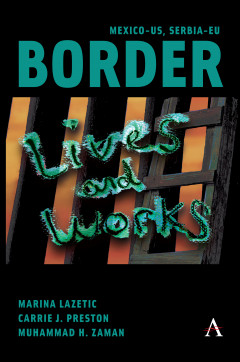Mexico-US, Serbia-EU Border Lives and Works
Edited by Marina Lazetic
Carrie Preston
Muhammad Zaman
Other Formats Available:
E-Book- About This Book
- Reviews
- Author Information
- Series
- Table of Contents
- Links
- Podcasts
About This Book
- Mexico–US, Serbia–EU Border Lives and Works pushes the boundaries of traditional border studies by incorporating perspectives beyond the humanities and social sciences, engaging engineers, public health scholars, humanitarian practitioners, human rights activists, and artists. Through accessible and interdisciplinary exploration, the book examines the Mexico–US and Serbia–EU border regimes, providing a nuanced understanding of these spaces as sources of inspiration, sites of research and ethical dilemmas, locations of service, and for many contributors, a place to call home. Across four sections, the edited volume fosters conversations that traverse disciplines while addressing conflicting perspectives on border-making, life at the border, and migration across borders.
- A central theme of the book emerges as writers engage with ethical concerns raised by conventional research methods, such as interviews and surveys, and the challenges posed by incorporating insights from diverse fields. Contributors critically reflect on these dilemmas, offering perspectives that traditional border studies often overlook. The result is a multifaceted engagement with border regimes, presented through qualitative research, cultural and textual analysis, art installations, personal essays, and interviews.
- Mexico–US, Serbia–EU Border Lives and Works aims to reframe existing conceptions of US and EU border regimes, highlighting how governments, NGOs, media, researchers, and citizens respond to migration, often in conflicting ways. It situates Serbia and Mexico’s border politics within the global context of “migration management,” emphasizing that border regimes developed by the United States and the European Union affect more than just the movement of people. They reshape the social, cultural, and political fabric of communities, influencing protests, hospitality, and artistic expression.
- By critiquing policies and practices that harm migrants, asylum seekers, and host communities, this book seeks to inform activism and policymaking in the United States, European Union, Mexico, and Serbia. It advocates for intersectional and collaborative research that bridges disciplines and speaks effectively to policymakers, activists, and broader communities. By addressing the complexities of migration and displacement alongside the systems that support people on the move, Mexico–US, Serbia–EU Border Lives, and Works highlights the need for border research and policy informed by the lived experiences of displaced populations and their hosts, as well as the work of humanitarian actors, artists, and activists.
Reviews
Author Information
Marina Lazetic is the director of programs at the Center on Forced Displacement at Boston University and a PhD candidate at the Fletcher School at Tufts University. Her research focuses on civil society's response to migration and forced displacement, border regimes, and practices of migration securitization.
Carrie J. Preston is a professor of English and Women’s, Gender, & Sexuality Studies and associate director of the Center on Forced Displacement at Boston University. Her current writing advocates for the field of critical forced displacement studies as a rubric for understanding art and activism in an age of global mobilities.
Muhammad H. Zaman is an HHMI professor of Biomedical Engineering and Global Health and the director of the Center on Forced Displacement at Boston University. His current research focuses on health systems, barriers, and access to healthcare among forcibly displaced communities.
Series
Table of Contents
Links
Stay Updated
Information
Latest Tweets



